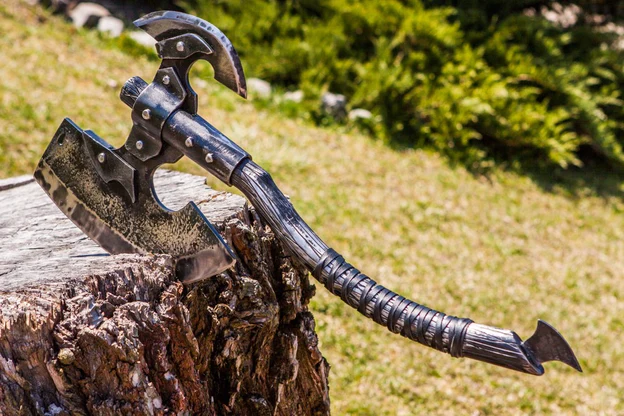When we conjure up images of the Vikings, fierce warriors dressed in horned helmets and wielding mighty battle axes immediately come to mind. The power of the Viking axe is a captivating aspect of their history that deserves a closer look. These brutal weapons were not simply instruments of destruction, but also symbols of status and ingenuity.
The origins of the Viking axe can be traced back to around the 8th century. These formidable weapons were essential to the Viking way of life, serving as tools for everyday labor as well as instruments of war. The Vikings were seafaring explorers and traders, and their axes were versatile companions in their relentless pursuits
The Viking axe was characterized by its distinct design. Unlike the traditional double-bladed axes that existed at the time, Viking axes featured a single cutting edge with a broad, flat blade. This unique shape allowed them to cleave through armor and shields with ruthless efficiency. The long handles of the axes provided the warriors with increased reach, enabling them to strike their enemies from a safe distance.
But the Viking axe was more than just a weapon. It also held a significant cultural and symbolic value. Norse mythology was deeply intertwined with Viking society, and axes played a prominent role in their legends. The most famous of these myths is the story of Thor, the Norse god of thunder, who wielded the mighty Mjölnir, a magical war hammer that helped protect Asgard, the realm of the gods.
In Viking culture, men who possessed superior crafting skills were highly esteemed. These skilled artisans crafted intricate, beautifully decorated axes, often inscribing them with intricate patterns and symbols. These ornate axes were not only a testament to the craftsmanship of the Vikings but also status symbols, worn proudly by the most esteemed warriors.
The Viking axes were not limited to just the battlefield, though. It was also a tool used for everyday chores such as woodworking and farming. Its dual functionality made it an indispensable tool for Viking farmers, who relied on axes to clear land, build homes, and even fashion their own boats.
As the Viking Age progressed, so did the evolution of the axe. The long axes used primarily for battle started to be replaced by shorter, more compact versions known as hand axes. These hand axes were easier to carry and provided warriors with better maneuverability in close-quarter combat. They were often used in conjunction with shields, creating a formidable defense and offense combination on the battlefield.
While the Viking Age eventually came to an end, the legacy of the Viking axe lives on. This iconic weapon continues to captivate our imagination, with countless movies, books, and games paying homage to its formidable power. The Viking axe represents ferocity, bravery, and the indomitable spirit of the Norsemen.

Lois Lane is a professional blogger and a seasoned Content writer for wellhousekeeping.com. With a passion for simplifying complex Home Decor topics, he provides valuable insights to a diverse online audience. With four years of experience, Lois has polished his skills as a professional blogger.



